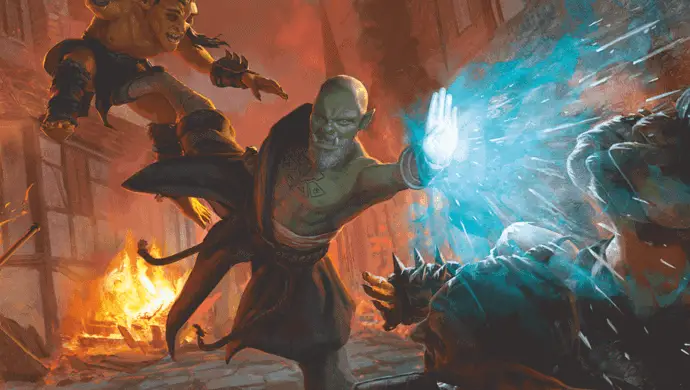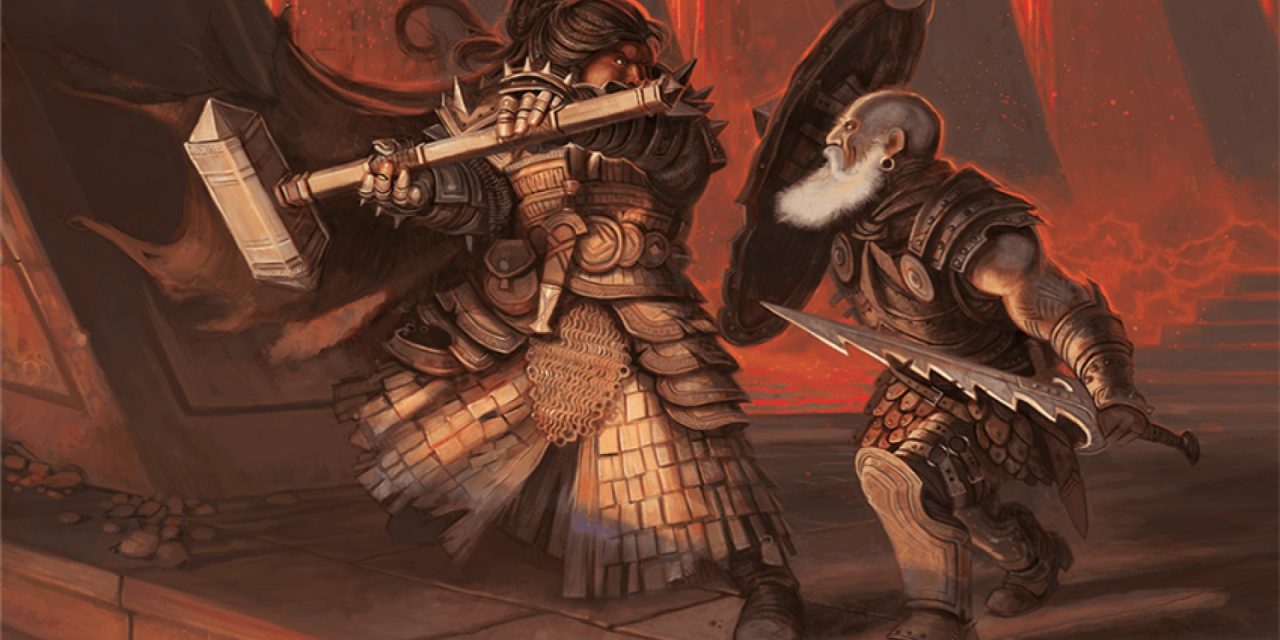“Roll for initiative!”
Those three words spoken by the Dungeon Master are enough to send a thrill of excitement (or dread) down any player’s spine. They’re legendary, iconic, and a time-tested part of what makes D&D so magical!
In D&D 5e, initiative is a very important aspect of combat. It determines the order in which combatants take their turns in battle.
When the DM is asking for initiative rolls, it’s time for the swords to start swinging and the spells and arrows to start flying!
In this article, we will discuss how initiative works in D&D 5e. We’ll also go over some tips for maximizing its effectiveness in your campaigns!
What Is Initiative in D&D 5e?
In D&D 5e, initiative is the mechanic that determines the order in which creatures act during combat.
The player with the highest initiative roll goes first, followed by the player with the next highest roll, and so on.
The Initiative mechanic is meant to add some level of structure to combat encounters. Of course, the turn order also plays a large part in how combatants may work together strategically.
Initiative may be a single roll, but it’s one of the most important rolls you’ll be making. (And you’ll likely be making A LOT of initiative rolls in your adventuring career!)

Rolling and Calculating Initiative
As combat begins, the Dungeon Master will ask everyone to roll initiative. Players all roll for their initiatives and the DM will roll initiatives for the enemies that the party is facing.
The calculation for initiative is:
d20 + dexterity modifier + any other bonuses
When the DM asks you to roll initiative, roll a d20. (This is the twenty-sided die that you use for most of your rolls in D&D. You can learn more about the different types of dice here!)
The result on that die is your base roll. Now we need to add any relevant bonuses or modifiers to that roll!
Now, add your Dexterity modifier to the roll.
This number is based on your Dexterity score and will have either a plus or minus in front of it (unless your Dexterity score is 10, in which case the modifier is zero.)
If your Dexterity score is less than 10, you’ll be subtracting from your base roll. If it is 12 or more, you’ll be adding to it. A Dexterity score of 10 or 11 gives you a 0 modifier so you’ll neither add nor subtract for your initiative roll.
Finally, add any bonuses to your initiative roll that you might be getting from class features, magic items, feats, or anywhere else.
You Might Like: How to Read Your Character Sheet in D&D 5e
Example – Rolling Initiative
So let’s say two characters (we’ll call them Bertley and Gartok) both roll a 12 as their base roll.
Bertley is a brainy Wizard, but he’s a bit clumsy. He has a Dexterity score of 8 which means his modifier is -1. Meanwhile, Gartok is an agile Ranger with a Dexterity score of 16. Gartok’s Dexterity modifier is +3.
So each character’s total initiative roll looks like this:
Bertley = 12 (base roll) – 1 (Dex modifier) = 11
Gartok = 12 (base roll) + 3 (Dex modifier) = 15
Gartok will be going on initiative count 15 while Bertley will be going on initiative count 11. While they both rolled the same on their d20, Gartok is quicker than Bertley so he’s able to go sooner in combat!
An Initiative Tip for DMs
Players only need to worry about their own initiative rolls but DMs need to manage the initiatives for everyone else in the combat. If the party is only fighting a couple of enemies, that’s not such a big problem.
But what if they’re fighting a larger group of enemies?
For example, let’s say the party is fighting against a group of goblinoids. There might be 5 goblins, 2 bugbears, and their hobgoblin leader. That’s a total of 8 enemies.
A key part of keeping combat fun and engaging is to keep things moving quickly. Anticipation is high when everyone is rolling initiative, so you don’t want to get bogged down by rolling and keeping track of 8 different initiatives!
Instead, streamline the initiative process to keep things quick and simple.
Roll one initiative roll for each enemy type. The goblins share a roll, the bugbears share a roll, and the lone hobgoblin gets their own.
Now you only need to make 3 initiative rolls instead of 8. That means you’ll be able to get combat moving much faster and get straight to the action!

Initiative Ties
It doesn’t happen often, but it’s also inevitable that you’ll get multiple combatants with the same initiative total. When that happens, you need a way to determine who goes first that is fair.
If we’re going by the book, the DM decides the combat order if the tie is between two or more of the enemies or between an enemy (or enemies) and a player. If the tie is only between player characters, the players can decide.
Alternatively, the DM can have everyone who got the same initiative total roll a d20 as a tiebreaker. Whoever rolls the highest goes first on the initiative count (amongst those tied).
Personally, I do it a little differently.
In the event of a tie, whoever has the highest Dexterity score goes first on that initiative count. I do this to reward characters with higher Dexterity scores because they frequently rely the most on being able to act earlier in combat.
If it’s two players that tied, I still leave the option open for them to decide who goes first. If neither cares, we just go based on Dexterity. For ties between monsters and a player, it’s entirely up to the Dexterity score.
But what if they also have the same Dexterity score?
In that case, we usually have a good laugh and then just have everyone who’s tied for the initiative count roll a d20 as a tiebreaker.
It’s not a huge departure from the rules as written, but it does give that extra little nudge in favor of quicker combatants.
Related: Ability Scores in D&D 5e Explained
Tracking Initiative
As combat begins, it starts with the combatant who has the highest initiative. After they take their turn, it moves to the next highest initiative count, and so on.
Once the character with the lowest initiative count has finished their turn, the next round of combat begins and it starts back from the top.
Keeping track of initiative is incredibly important for both DMs and players.
Of course, the DM needs to be able to keep everything moving smoothly since they are juggling multiple enemies. But players also benefit from keeping track of initiative so that they can plan what they’re going to do on their turn.
Making sure that you have an idea of what you’re going to do on your turn is one of the keys to keeping combat exciting and moving smoothly.
Both DMs and players should make that a habit!
If you’re playing D&D in-person, you can keep track of initiative on some scratch paper or using index cards. Alternatively, you might also like a digital initiative tracker like this one from DM Tools.
If you’re playing online via a Virtual Tabletop (VTT) most of your options have built-in initiative trackers.

My Favorite Tool
Combat can be hectic and it can be hard to keep track of whose turn it is. That can then lead to a lot of confusion in the middle of a heated battle.
This uncertainty can lead to critical mistakes in the middle of a fight. This is especially true of combats that have a large number of characters to keep track of.
Next thing you know, you’ve got turns getting skipped and all kinds of chaos breaking out!
A simple tool that greatly leveled up my games is this initiative tracker/combat pad.
This handy board includes magnets that stick right to it, so you can list the names of heroes and foes on the magnets using a wet or dry-erase marker, then place them in initiative order.
From there, you can easily track turn orders (and even death saving throws!) while also having ample room to make quick notes as you need.
Not to mention, it’s a lot tidier than keeping piles of scratch paper!
I’m slow to call something a game-changer, but this has been one of my favorite accessories for several years now!
Improving Your Initiative Rolls
If you’re looking to improve your initiative rolls, there are a few options beyond just increasing your Dexterity score.
First up, you might consider taking the Alert feat. This gives you an additional +5 to your initiative rolls. (Note that that is on top of your Dexterity modifier. If you’ve got a Dexterity score of 20, you’ll be rolling initiative with a whopping +10!)
Related: Feats in D&D 5e Explained
Next, look at bonuses from your race, class, or subclass that apply to your initiative. While not an exhaustive list, some examples include:
- Gloom Stalker Rangers add their Wisdom bonus to initiative rolls with their Dread Ambusher feature.
- Swashbuckler Rogues add their Charisma bonus to initiative rolls with their Rakish Audacity feature.
- War Magic Wizards add their Intelligence bonus to initiative rolls with their Tactical Wit feature. Chronurgy Wizards get the same benefit from their Temporal Awareness feature.
- Oath of the Watchers Paladins gain Aura of the Sentinel which lets them and nearby allies add their proficiency bonus to their initiative rolls.
- Level 7 Barbarians get advantage on their initiative rolls with the Feral Instict feature.
- Level 2 Bards add half of their proficiency bonus to their ability checks (including initiative rolls) with Jack of All Trades.
- Twilight Clerics can give themselves or allies advantage on an initiative roll with their Vigilant Blessing feature.
- Champion Fighters get the Remarkable Athlete feature which lets them add half of their proficiency bonus to Strength, Dexterity, and Constitution checks (including initiative rolls).
- Harengon characters have the Hare-Trigger feature which allows them to add their proficiency bonus to their initiative rolls.
Of course, there are also some spells that will help you pump up your initiative rolls! Some standout spells are:
- Guidance (cantrip) – Add 1d4 to an ability check (includes initiative rolls)
- Enhance Ability (Level 1) – Cat’s Grace option gives advantage on Dexterity checks (including initiative).
- Gift of Alacrity (Level 1) – Add 1d8 to initiative rolls.
- Foresight (Level 9) – Incredibly strong buff that gives advantage on initiative rolls (among so much more!)
Advantages and Disadvantages of Going Early
There are plenty of advantages to going earlier in combat.
For example, you can take out the enemy spellcaster before they have a chance to unleash their spells. Alternatively, you could lock down a big enemy with a spell or feature before they have a chance to start damaging you and your party.
But initiative is not always about going first. Sometimes, it’s about timing your actions in such a way that you can take advantage of the situation.
That’s where choosing to ready an action comes in.
Anticipating what’s coming up in combat and setting how your character will react to a specific trigger adds a new level of strategy to the game. You can learn more about that in my guide to the Ready Action.
Of course, there are also certain disadvantages to going first in combat.
For example, if you’re not careful, you could find yourself surrounded by enemies who are all attacking at once. While you are the one kicking the whole thing off, you might bite off more than you can chew if you aren’t careful!
Whether you’re going first, last, or somewhere in between, keep your wits about you!
You Might Like: How to Make Your First D&D Character

FAQs – Initiative in D&D 5e
Before we wrap up this guide, I want to take a moment to answer some common questions about initiative in D&D 5e.
If you’ve got a question that hasn’t been answered in this guide, leave a comment below. I’m always happy to help!
Do You Roll for Initiative Every Round?
Initiative is typically only rolled right at the start of combat before the first round. When a round ends, the rotation goes back to the top of the list and begins working its way down again.
However, there are some groups that like to roll initiative every round. The goal here is to keep it random and better capture the hectic frenzy of actual combat.
Personally, I like that idea in theory, but it didn’t work in practice at my table. If you can do it in a way that doesn’t slow down the game too much, it might be worth a try though!
Does Jack of All Trades apply to Initiative?
The Bard’s Jack of All Trades feature lets them add half of their proficiency bonus to any ability check that they do not already add their proficiency bonus to.
Remember that initiative rolls ARE ability checks and would therefore benefit from this feature.
If you’re playing a Bard, make sure you don’t forget this one!
Can You Get Expertise in Initiative?
Rogues get a cool feature called Expertise that lets them double their proficiency bonus for certain skill checks that they choose.
However, the wording here is very specific that it must be a skill check. That means that Expertise would apply to skills like Stealth, Deception, Acrobatics, etc.
Initiative is an ABILITY check, not a skill check. So, the Rogue’s Expertise feature would not apply here.
Do Monsters Roll Initiative?
Everybody in combat rolls initiative as combat begins.
This includes the party, whatever enemies they are facing, and potentially even noncombatant NPCs who are trying to get out of the crossfire.
As mentioned above, it’s best for DMs to roll a single initiative for all monsters/enemies of a certain type. This keeps things moving along quickly.
Is Initiative an Ability Check?
Initiative is a Dexterity ability check.
Bonuses or penalties to Dexterity ability checks like the Bard’s Jack of All Trades feature (bonus) or being exhausted (penalty) therefore also apply to initiative rolls.
Do You Add Proficiency to Initiative Rolls?
Unless you have a feature or some other effect that allows you to do so, you do not add your proficiency bonus to initiative rolls.
This could be something like the Harengon racial feature, Hare-Trigger, or the Aura of the Sentinel from an Oath of the Watchers Paladin.
Conclusion – Initiative in D&D 5e
Thanks for reading!
Initiative can be a complex topic, but I hope this article has given you a better understanding of how it works. Be sure to use these tips to your advantage in your next combat encounter!
Do you have other questions about initiative in D&D 5e? Let me know in the comments below and I’m happy to help!
Don’t forget to sign up for the Tabletop Joab newsletter! It’s the best way to get all the latest player guides, DM Tips, news, reviews, and more for D&D 5e right to your inbox!
You can also follow me on Facebook and Twitter.
If you found this article helpful and want to support the site, you can buy me a coffee here! (It’s not expected, but very appreciated!)










